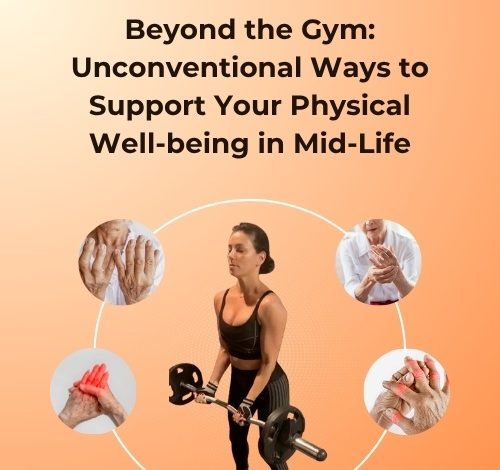Beyond the Gym: Unconventional Ways to Support Your Physical Well-being in Mid-Life

As you reach your 40s and 50s, staying physically well often requires more than hitting the gym a few times a week. You might notice your body responding differently — slower recovery, more stiffness in the mornings, and perhaps new aches that weren’t there before. While regular exercise remains important, it’s not the only piece of the puzzle. If you’re looking for fresh and realistic ways to support your body in mid-life, there are several lesser-known strategies that can make a real difference.
Let’s explore how you can support your physical well-being beyond traditional workouts.
7 key aspects of physical well-being
Here are 7 key aspects of physical well-being to help you maintain a healthy and balanced life:
1. Move With Purpose Throughout the Day
You don’t have to run marathons to keep active. Mid-life often brings long hours of sitting — at desks, in cars, or on sofas. These habits can stiffen joints and weaken muscles, no matter how often you exercise.
Try integrating gentle movement into your daily routine:
- Take a walk after meals
- Use the stairs more often
- Stretch while watching TV or during work breaks
- Try balance-based exercises like tai chi or mindful yoga
These low-impact movements help support joint flexibility, posture, and coordination — all essential for staying mobile and independent.
2. Prioritise Recovery, Not Just Activity
As your body ages, it needs more time to recover from physical strain. If you feel sore for longer after exercise or physical tasks, that’s normal. Prioritising rest and muscle repair is just as important as the activity itself.
Consider:
- Warm baths with Epsom salts
- Gentle foam rolling or self-massage
- Quality sleep (aim for 7–9 hours per night)
- Short naps if you’re fatigued mid-day
Also, don’t overlook the role of good hydration and protein intake in recovery. Both help reduce inflammation and support muscle repair.
3. Support Joint Health With Natural Options
Joint stiffness and discomfort are common in mid-life, particularly in the knees, hips, and lower back. While physiotherapy and stretching help, some people turn to natural approaches to ease inflammation and promote joint mobility.
One option worth exploring is a Joint Support Herbal Supplement for Arthritis. These can contain ingredients such as turmeric, boswellia, ginger, and ashwagandha — all known for their anti-inflammatory properties. These Natural Joint Supplement may help ease morning stiffness, improve range of motion, and reduce reliance on over-the-counter pain relief.
Always consult a healthcare provider before starting any new supplement, especially if you’re on medication.
4. Use Mind-Body Techniques to Ease Tension
The connection between stress and physical tension becomes more apparent as you age. Chronic stress can lead to tight shoulders, clenched jaws, and tension headaches — all of which affect your ability to move comfortably.
Incorporating mind-body techniques can reduce this strain:
- Deep breathing or guided relaxation
- Meditation or mindfulness apps
- Progressive muscle relaxation
- Gentle breath-led movement like Pilates
Regular practice can improve your sleep quality, help you stay calm under pressure, and even improve your pain threshold.
5. Rethink How You Sit and Stand
Posture isn’t just about how you look — it’s about how you feel. Poor posture contributes to back pain, headaches, and restricted movement. With age, posture naturally changes, but you can slow or reverse some of those changes.
Simple strategies:
- Use a lumbar cushion when sitting
- Keep screens at eye level to avoid neck strain
- Take movement breaks every 30 minutes
- Strengthen core muscles to support your spine
Even a few small changes to how you move through the day can ease long-standing discomfort.
Related Article: Are You Taking the Right Supplements for Arthritis? Find Out Today!
6. Eat to Support Muscle and Joint Function
Food plays a key role in how your body feels and functions. As you age, your protein needs increase to preserve muscle mass. You also need a wide range of nutrients to support joint and bone health.
Try to include:
- Omega-3 fatty acids from oily fish, flax, or chia seeds
- Calcium and vitamin D from leafy greens, dairy, or fortified foods
- Antioxidants from colourful fruits and vegetables
- Spices like turmeric and ginger, which may help reduce inflammation
Meal planning with these nutrients in mind can have long-term benefits for your energy levels and resilience.
Related Article: The Shocking Truth About Arthritis Cures – What Really Works?
7. Get Professional Support When Needed
You don’t need to wait until something breaks before you seek support. Regular check-ins with a physiotherapist, osteopath, or sports therapist can help you spot imbalances early and improve your movement quality.
They may recommend:
- Strengthening specific muscle groups
- Adjustments to your form during everyday tasks
- Supportive footwear or insoles
- Techniques to improve alignment and reduce wear on joints
Final Thoughts
Supporting your physical well-being in mid-life requires a broader approach than exercise alone. Small daily habits — from mindful movement and posture to nutrition and stress management — all contribute to how your body feels and functions.
And remember, if joint stiffness or discomfort is holding you back, a natural Joint Support Herbal Supplement for Arthritis may offer gentle support as part of a wider plan. Mid-life doesn’t have to mean slowing down — it means supporting your body in smarter, more sustainable ways.




